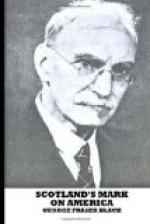John Smibert (c. 1684-1751), born in Edinburgh, came to America in 1728 and settled in Boston, where he met success as a portrait painter. He was the first painter of merit in the colonies, and painted portraits of many of the eminent magistrates and divines of New England and New York between 1725 and 1751, the year of his death. His work had much influence on the American artist, John Singleton Copley. Gilbert Charles Stuart (1755-1828), born in Rhode Island of Scottish parents, was the foremost American portrait painter of his day. He painted several portraits of Washington, and also portraits of Presidents John Adams, John Quincy Adams, Jefferson, Madison, Justice Story, Fisher Ames, John Jacob Astor and others. Cosmo Alexander, a skilled portrait painter, born in Scotland, was his teacher for a time. Charles Fraser (1782-1860), born in Charleston, South Carolina, of Scottish ancestry, first studied law and retired with a competency. He then took up art and achieved eminent success in miniature painting and as a painter of landscapes, pictures of genre, still life, etc. William Dunlap (1766-1839), artist and dramatist, founder and early Vice-President of the National Academy of Design, was of Ulster Scot descent. His family name was originally Dunlop. Robert Walter Weir (1803-89), of Scots parentage, is best known for his historical pictures, he being one of the first in America to take up this branch of the art. “The Embarkation of the Pilgrims” (1836-40) in the Rotunda of the Capitol at Washington is by him. Russell Smith, born in Glasgow in 1812, was a scientific draughtsman and landscape painter. Two of his finest landscapes, “Chocorua Peak” and “Cave at Chelton Hills” were exhibited in the Philadelphia Exhibition of 1876. His son, Xanthus (b. 1839), was a well-known marine and landscape painter and painted many of the naval engagements of the Civil War. James Hope, born near Abbotsford in 1818, settled in New York in 1853, distinguished as a landscapist, was chosen an Associate of the National Academy in 1865. Alexander Hay Ritchie (1822-95), born in Glasgow and educated in Edinburgh, was a most successful painter in oils as well as an engraver in stipple and mezzotint. His paintings of the “Death of Lincoln” and “Washington and his Generals,” obtained great popularity. As a portrait painter fine examples of his work are “Dr. McCosh” of Princeton, “Henry Clay,” etc. He also did a good deal of book illustrating. Thomas Lachlan Smith (d. 1884), also born in Glasgow, was noted for his Winter scenes. Two notable pictures of his, “The Deserted House” and “The Eve of St. Agnes,” were exhibited at the Centennial Exhibition. Still another Glasgow artist, John Williamson (1826-85), born at the Tollcross in that famous city, became an Associate of the National Academy, and made the scenery of the Hudson and the Catskills his special study as shown by his “The Palisades,” “Sugar Loaf Mountain,” “Autumn in the Adirondacks,”




